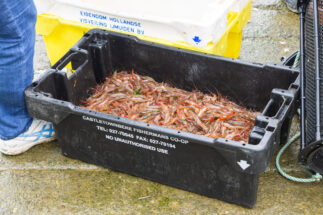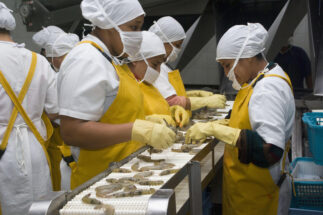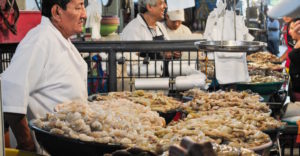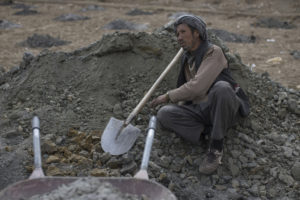“Yes, there were dismissals. I was pregnant at the time. Several of my friends were laid off, but now they are hiring. Let’s hope that everything gets better,” said María, a 30-year-old woman who asks not to be identified by her real name to avoid problems at the shrimp-packing plant where she works, in the north of Guayaquil. “We didn’t know when it was our turn”.
María’s story underscores the uncertainty that workers in Ecuador’s shrimp industry have experienced since March 2020, when the COVID-19 pandemic began to affect the sector. Shrimps are highly sought after in China, the US and Europe and have been the focus of a trade boom in recent years. But the Ecuadorean industry is now also contending with rising numbers of shrimp thefts by pirates.
A year of ups and downs for Ecuador’s shrimp
2020 was a tough year for Ecuador’s shrimp industry. Internationally, prices and demand fell, and especially in China, which in recent years has become its main market, according to a statement the Ecuadorian National Chamber of Aquaculture (CNA) gave to Diálogo Chino.
In July 2019, Ecuador sent 123 million pounds of shrimp to the Asian country, worth $US324million. A year later, it sent 98 million pounds, valued at $233 million, some $90million less.

From July to November, however, sales rebounded: in the latter month, 154 million pounds were sold for $US367 million. Then, the sector closed 2020 with another drop: 10 million pounds less were sold in December compared with a year earlier, which meant another $56million drop in takings.
18,000
jobs were lost in the livestock, forestry and fishing sector between 16 March 2020 to 7 January this year
These ups and downs meant that between 16 March 2020, when a state of emergency was issued in Ecuador to contain the pandemic, and 7 January this year, 18,000 jobs were lost in the livestock, forestry and fishing sector. This includes shrimp farmers, according to figures from the Ministry of Labour.
In the midst of the economic crisis caused by the pandemic, the Ecuadorean shrimp industry also had to deal with other problems. The Chinese authorities suspended imports from Ecuadorean exporters for about a month because of a health warnings. It imposed sanctions last July after inert traces of Covid-19 were found on the wall of a container, in addition to traces of another disease – the white spot virus – that had been detected last January.
In 2019, Beijing also imposed sanctions on several Ecuadorean companies for outbreaks of white spot and yellow head, another viral disease that affects vital organs in animals.
This led the sector to make changes. The CNA implemented more rigorous biosecurity protocols, which, as it told Diálogo Chino, meant that companies had to disinfect product processing areas, storage warehouses, packaging, the inner walls of containers and personnel who have contact with the shrimp.

“We are working to strengthen the reputation of the product after the sanctions issued by the Chinese authority (…) We are convinced that with the hard work we are doing, trade between the two countries will continue to grow,” the CNA said in a statement.
In addition to this, workers undergo Polymerase Chain Reaction (PCR) testing for coronavirus every 60 days and submit the results to the health authorities.
If a case is detected in the shrimp processing area, the company must stop work while it is cleaned and disinfected to eliminate any traces of the virus, and that product will not be exported, the union explained.
Shrimp pirates in Ecuador
Aside from the pandemic, the shrimp industry is calling for better protection of its cargo following a recent wave of robberies at sea and along river routes.
One of the most recent cases occurred on 2 December. The crew of a vessel transporting shrimp to Guayaquil was intercepted by pirates in the area known as Chupadores Grande. An image released by the CNA shows one of the crew members with a bloody arm. Marines assisted the young man and his crew.
That was one of nearly 100 thefts reported by shrimp farmers last year. Seven deaths and 60 injuries resulted from pirate attacks, according to CNA records.
“We see that the National Police and the Ecuadorean Navy, either for lack of economic, logistical or any other kind of resources, cannot guarantee the security of the sector,” said José Antonio Camposano, president of the CNA.
According to the union, product losses due to theft have exceeded US$2.5 million. In addition to this figure, investment in security exceeds US$60 million per year.
Beyond the public safety problem, the thefts could impact public health. There is a risk that the stolen loads will be improperly handled and that the shrimp will not be kept at the right temperature, according to two trade union leaders, who also asked to remain anonymous to avoid reprisals.
The stolen shrimp route
Pirate gangs dock shrimp vessels near ports, close to the islands and branches of the estuaries of the Gulf of Guayaquil and the Jambelí Archipelago. The stolen cargo is then unloaded, say the leaders, both at regular docks in large cities and at irregular docks in places that are difficult to access. In the Huaylá estuary alone, police have identified 60 locations.
“I have an irregular beheading plant (where shrimp are topped prior to packing) and, as the packing plants are also supplied by different suppliers, they mix with shrimp that they buy in small places,” says one producer.
Another shrimp pool owner who has suffered theft describes another way that stolen shrimp enter into the system: “It is very easy to camouflage. There are cases of shrimp farms that have their papers in order. They are small shrimp farms of 10-15 hectares, but they produce as if they were a thousand hectares.”
It is unlikely that the stolen goods will end up in the cargo exported to China
He said that they present the invoice, or the waybill, so that the shrimp enters the export system. Some packers turn a blind eye because they want to fill their quotas.
However, Camposano says it is unlikely that the stolen goods will end up in the cargo exported to China, due to sanitary controls that are carried out on all batches.
“The shrimp that goes to China is accompanied by a series of analyses that are carried out at the time of harvesting and then at the time of packing. So a stolen shrimp is hardly going to have the analysis for white spot that the Chinese authorities require if it comes from an illegal act, because this analysis shows the farm and pool number,” he assured Diálogo Chino. He added that China does not buy headless shrimp.
“Today, in view of the demands that China has put on the table to be able to sell the product to their country, it is really very difficult for a large, medium or small company to risk acquiring a product over which it has no control in the chain of custody, does not know the temperature, does not know many things, to pack it today to the most demanding market,” he added.
Camposano also echoes producers’ calls for extra security to reinforce maritime and land patrols.
Operation Safe Shrimp
Protection at sea is the responsibility of the navy, which has a security plan for the shrimp sector.
1,620
safety operations were organised in 2020
“Based on what is described in the Comprehensive Security and Protection Plan for Aquatic Spaces, the Ecuadorean navy, through the coast guard command and port captaincy, executes the so-called ‘safe routes’. We also have the support of the Marine Corps and Naval Aviation, which allows us to provide the security required by the different maritime unions when required,” a Navy spokesperson told Diálogo Chino, detailing several safe routes.
According to navy records, 1,620 safety operations were organised in 2020. The navy recommends that shrimp farmers use these safe routes, which use river corridors between shrimp ponds or farms to ports and regular city docks, although they remain difficult to patrol.
However, the defence sector has not been immune to the economic crisis. In the middle of last year, defence minister Oswaldo Jarrín ordered the suspension of naval operations because they did not have insurance.
“When there is financial unsustainability or lack of liquidity to cover these quotas, it means that it does not depend on the ministry of defence, it depends on the ministry of finance. For this reason, as there were insufficient funds, a 60-day extension (of the insurance) was requested,” Jarrín told the National Assembly on 10 June 2020. The policy had expired four days earlier and the suspension of naval operations lasted about that long.
The navy is not the only institution overseeing the safe routes strategy for the shrimp industry. The chief of police in the city of Puerto Bolívar, Wilson Narváez, said extra guards and security measures are in place for the sector. These include patrols on the roads where trucks from the border town of Huaquillas, near Peru, travel to other parts of El Oro province.
“They inform us that from 3 to 5 in the morning all the trucks are going to pass. At that time they take the harvested shrimp to Guayaquil (…) We make a post. If they leave Huaquillas, the person in Santa Rosa has to report: ‘Six trucks passed without incident’,” he explained to Diálogo Chino.
He also said that many assaults are not reported, that employers do not bring the names of their workers to them for background checks and that they do not prohibit the use of telephones during shrimp harvests.
Traceability of the Ecuadorean shrimp
Police, union leaders and shrimp producers agree there is a lack of controls at these “irregular” docks and no complete traceability system for shrimp shipments.
A comprehensive traceability system, with face-to-face controls by the authorities of institutions such as the vice ministry of Aquaculture and Fisheries, would also make it possible to detect possible stolen cargo, according to the producers consulted.
One producer argued that it was possible to distinguish shrimp harvested from the sea, and those that are not, and so it would be possible to have more checks.
Trade union leader Camposano insisted the problem was that the lack of public servants doing on-site controls meant more informal seafood traders.
In spite of this, he was optimistic about the new rules, part of the recent Aquaculture Law, under which registration by marketers with the vice ministry of aquaculture is compulsory. After obtaining authorisation, they will be able to apply for a single taxpayer register (RUC) at the Internal Revenue Service (SRI). “Through this control, you can cross-check the sale of shrimp with the remittance guides issued and thus verify that no stolen shrimp is being laundered,” he says.
Ecuadorian shrimp is the first in the world to incorporate blockchain technology to guarantee the complete traceability of its production
Diálogo Chino requested an interview with the Ministry of Production, Foreign Trade, Investment and Fisheries, under whose wing the shrimp sector falls, but did not receive a reply.
On 24 November, the minister of production, Iván Ontaneda, said, at the AquaExpo in Guayaquil, that “Ecuadorian shrimp is the first in the world to incorporate blockchain technology to guarantee the complete traceability of its production“.
According to the minister, “by scanning the QR code that comes on each package, anyone in the world will be able to know who, how and where the shrimp they are going to consume was farmed”.
Thirteen Ecuadorean packers, which account for 36% of exports, currently have this technology, according to Camposano. The rest do not have traceability through the QR code on the box, but you can enter a web page or write to the company,” he said.








